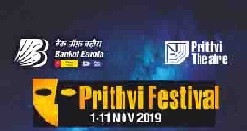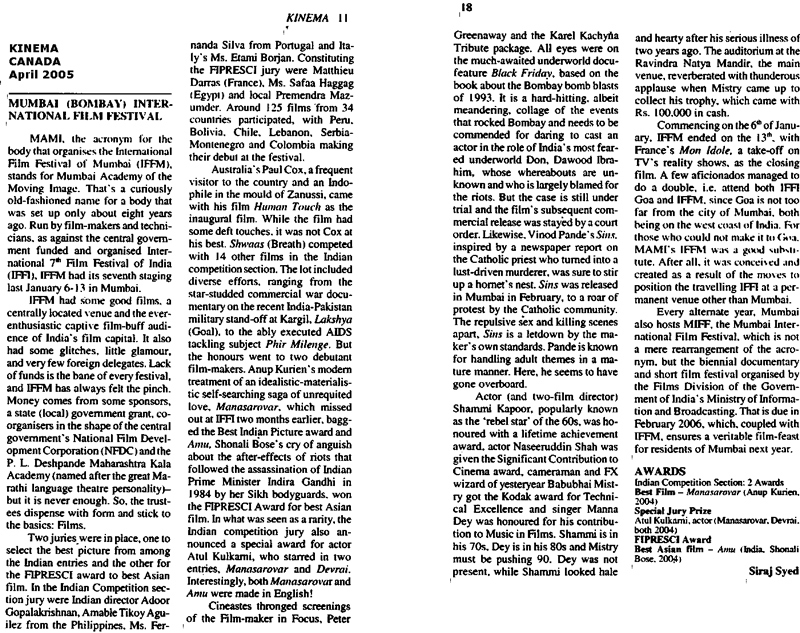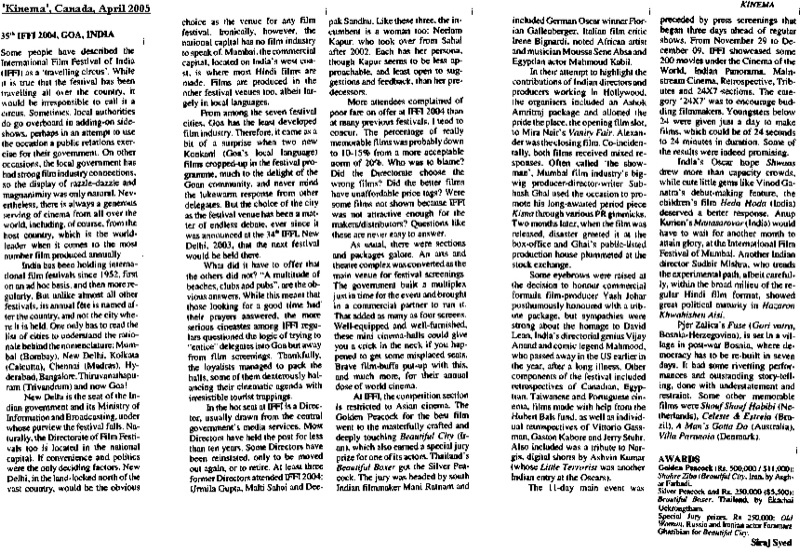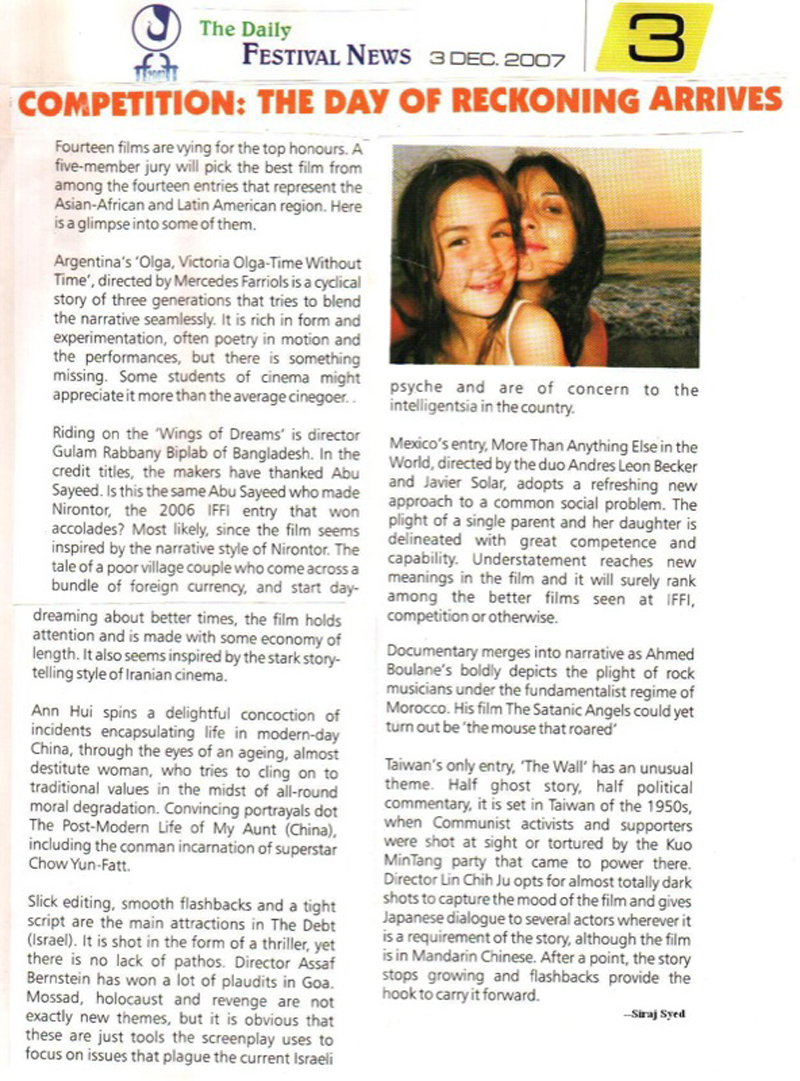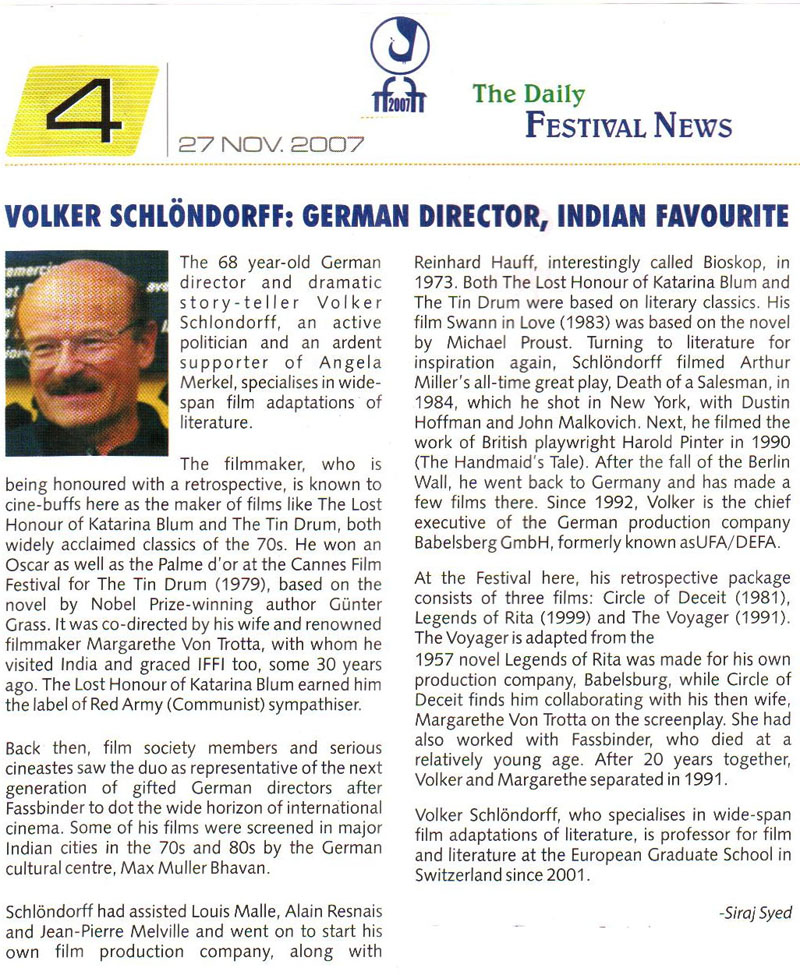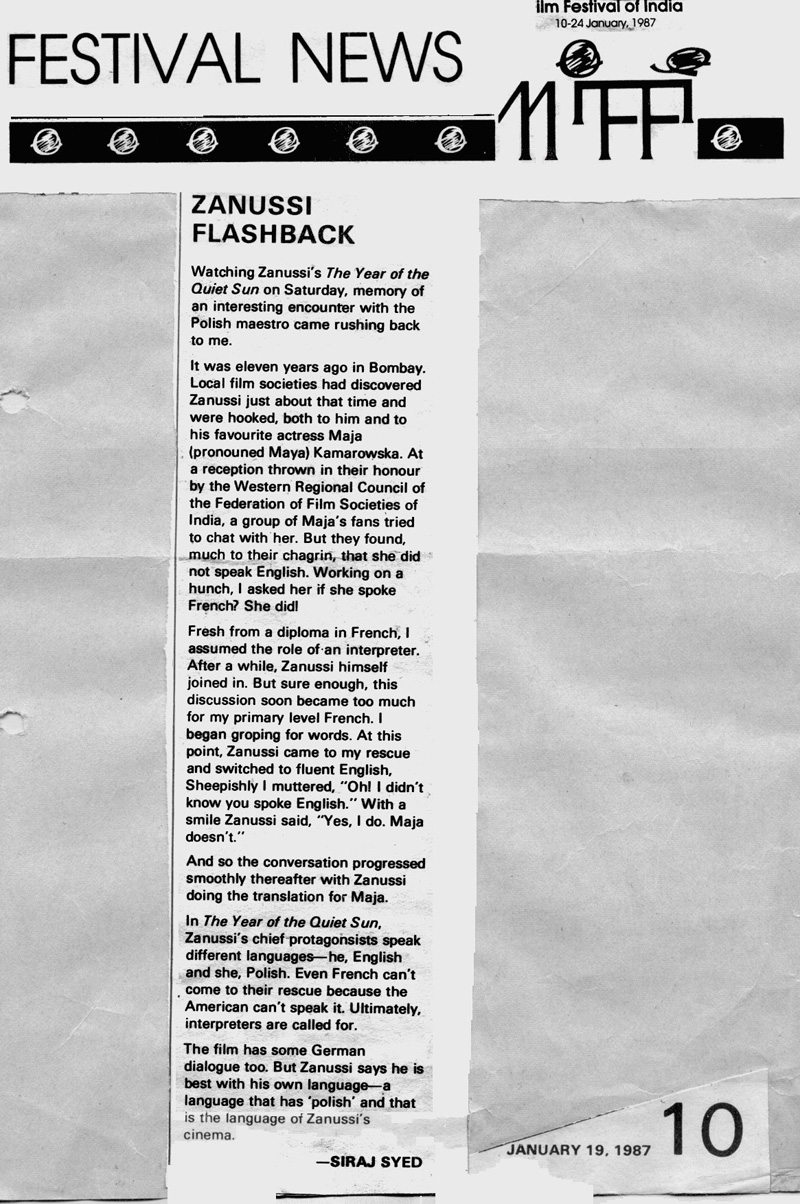|
|
||
|
Pro Tools
FILMFESTIVALS | 24/7 world wide coverageWelcome ! Enjoy the best of both worlds: Film & Festival News, exploring the best of the film festivals community. Launched in 1995, relentlessly connecting films to festivals, documenting and promoting festivals worldwide. Sorry for the interruption, we needed to correct and upgrade some modules. Working on a new website. For collaboration, editorial contributions, or publicity, please send us an email here. You need for put your full detail information if you want to be considered seriously. Thanks for understanding. User login |
Siraj SyedSiraj Syed is the India Correspondent for FilmFestivals.com and a member of FIPRESCI, the International Federation of Film Critics. He is a Film Festival Correspondent since 1976, Film-critic since 1969 and a Feature-writer since 1970. He is also an acting and dialogue coach. @SirajHSyed  Prithvi Festival: Piyush Mishra’s Gagan Damama Bajyo, rivetting study of the life and times of Bhagat Singh, sets the tone
Prithvi Festival: Piyush Mishra’s Gagan Damama Bajyo, rivetting study of the life and times of Bhagat Singh, sets the tone Besides Mohandas Karamchand ‘Mahatma’ Gandhi, two other freedom fighters are often cited as heroes of the Indian freedom struggle against its colonial British masters: ‘Netaji’ Subhashchandra Bose and ‘Shaheed’ Bhagat Singh. Bose went abroad, formed the Indian National Army (INA/Azad Hind Fauj) and waged armed battles against the oppressors on the Eastern front, though, in the end, he proved no match for the mighty British Empire. While Gandhi is revered as Mahatma or great soul, Bose is called Netaji, for his leadership abilities. Bhagat Singh indulged in many revolutionary movements, including a couple of acts of violence, but was hanged at the age of 23, too early to lead any popular movement himself. He is remembered as Shaheed, or martyr.
Piyush Mishra graduated from the National School of Drama, New Delhi, in 1986, and Hamlet was his first starring role. Later, he moved to Mumbai, to act in a couple of TV serials, but went back to Delhi to do theatre. His 1994 play, Gagan Damama Bajyo, partly inspired the 2001 film, The Legend of Bhagat Singh, for which he was invited to write the dialogue. Soon, his writing and acting career in cinema flourished, both as lyric-writer (Black Friday, Aaja Nach Le, Tashan) and actor (Maqbool, Jhoom Barabar Jhoom, Gulaal). Some twenty years after his last stage appearances, he returns to the theatre with Gagan Damama Bajyo, which is written and directed by him, besides penning the songs and composing them. You will see him on stage too, albeit very briefly. Gagan Damama Bajyo is a big and sparse musical play at the same time. It is big because it has so many characters, incidents and songs. It is sparse because it is symbolic and experimental in genre, with minimal costumes, only essential make-up and get-up, and virtually no sets or backdrops at all. The play includes revolutionary passionate and heart-tugging songs, written and composed by Mishra, to melodically express the sentiments of India’s freedom struggle. It explores all the varied human elements of Bhagat Singh’s life, and breaks the fundamentalist image of him, that people currently overuse, for he was as much inspired by Lenin and the French Revolution as he was by Gandhi and Lala Lajpat Rai. No truly fundamentalist personality is shown inspiring Bhagat. Gandhi gave him the slogan ‘Vande Maataram’--I revere my mother (land)’, when he visited Bhagat’s school in Lahore. He was eight years old then. The play shows him as a friend, a son, a lover, and an intellectual who found himself unable to sit back and watch in a country fighting for its freedom from oppression. A lot of his efforts were mentored by Pandit Chandrashekhar ‘Azad’ (free, independent) and he admired the movements launched by Gandhi and Lala Lajpatrai, the founder of the National College, where Indians, including Bhagat, could study, without any colonial yokes. Gagan Damama Bajyo chronicles key moments of the martyr’s life, from his induction into revolutionary ideology as a child, his exploration of that ideology as a young man at the National College in Lahore in 1923, to his death, by hanging, on March 23, 1931, on the charge of murdering a British policeman. The play looks at India s freedom movement through his eyes, his family’s eyes, his teenage crush’s eyes and the eyes of his bunch of young revolutionaries, spread across north, east and west India. The play shows us the effects of the Jallianwala Bagh massacre (1919; by General Dyer of the British army), on Bhagat Singh and his contemporaries, like Sukhdev Thapar, and Bhagwati Charan Vohra, among others, as they fought for autonomy, first under the Hindustan Republican Association, and then, when the HRA was banned, under the newly constituted Hindustan Socialist Republican Association where they met the stalwarts of the movement, like the militant body-builder, gun-toting, Pandit Chandrashekhar Azad. What happens when Singh along with other HSRA members, shoots a British policeman to avenge the death of beloved freedom fighter Lala Lajpat Rai forms the main plot line. Mishra, who legally changed his name from Priyakant Sharma to Piyush Mishra, showed a complete command over the proceedings, though he has some 20 characters to direct and dozens of complicated formations and blockings to set. Almost everybody gets an opportunity to mouth some pithy lines, the best of which, quite naturally so, (some are in English) are reserved for Bhagat Singh. Mishra ends the play in 1994, when the last surviving member of the group, poet Shiv Verma, passed away. Also running in parallel are meetings between and unidentified Comrade and first Batukeshwar Dutt, and later Shiv Verma. These are the only luxuries that Mishra indulges in, and, when contrasted with the bullet-like precision of the present time narrative (1923-31), they appear unnecessary flash-forwards to 1965 and 1994. Mishra met Verma during the course of his research, and it was Verma who gave Bhagat the title of Sardar (a leader; also used as a prefix to denote followers of the Sikh faith) and a tribute to his contributions was in order, but not is this way. Batukeshwar Dutt, who lived till 1965, on the other hand, emerges as a minor player, and the repeated meetings between him and the incognito Comrade add little to the story. Their dramatic effect too is muted. In a sense, 1965 is also significant as the year in which Manoj Kumar made his feature on Bhagat Singh, called Shaheed, considered a fine piece of patriotic cinema. And with the passing away of Verma, in 1994, an era ended. In terms of songs, Mishra uses popular numbers with a new, or, perhaps, the original flavour. He has a harmonium player, a folk singer (lok gaayak), singing the lead on stage, with three other musicians seated to the left of stage, one providing very loud percussion that sometimes reaches a jarring pitch. Prithvi Theatre has such good acoustics that the drum need not have been played so loud. A welcome inclusion is the poetry of Faiz Ahmed 'Faiz', three years Bhagat Singh’s junior, which is apt and blends with the theme. Actors have done highly competent jobs and it will be unfair to single out any one or two as outstanding. Mishra himself makes a cameo appearance at the end, singing a couple of numbers in characteristic style, not as a proficient singer, but as a kind of game-finisher. When he finishes, everybody is on stage, they turn their necks to stage right (our left), and freeze. Was that symbolic? Was the director trying to convey a leftist leaning? Maybe I am reading too much into a purely theatrical move. Headgear was seen only as a turban, a hat (the famous Bhagat Singh hat), an Englishman ranting in his colonial costume, and a bandage on the head of the actor who plays Batukeshwar and Mueen. Others were all in pure white.
Language used was a mix of Urdu and Hindi, though it should have been Urdu and Persian in 1923, when these two languages were more in use than the present-day Hindi, but a little more Hindi might make it more intelligible to 2019 audiences. When one actor said qhaatir tavajjoh, it jarred, because the Urdu term for welcome and looking after is qhaatir tavaazo. Overall, in a 100-minute play, a couple of such slip-ups do not detract much. Gagan Damama Bajyo is produced by Rahul Gandhi and Dilraj Kaur Sandhu (it has not been mentioned whether these two personalities belong to illustrious families, Gandhi being India’s ruling family for decades and Sandhu being the surname of no less an individual than Bhagat Singh himself, though hardly anybody knows this fact). Radheshyam Pipalwa is the third producer. Himanshu Talreja leads the cast as Bhagat Singh. Anadi Nagar is the lok gaayak, Jayant Pattnaik was on percussion and sound effects and Nishant Agrawal played the strings. The production team did a marvelous job, under Saleem Javed (one man; no, not the film writing ex-duo Salim-Javed). Lights were designed by Rahul Joglekar and the sound engineer was Varun Gupta. The Non Co-Operation movement, The Simon Go Back, The shooting of Saunders… they are all there as integral parts of the drama. In 1927, the British government appointed the Simon Commission to look into the issue of political reforms in India. But with no Indian member on the commission’s body, angry Indian nationalist leaders across the ideological spectrum boycotted the commission. In Lahore, Lala Lajpat Rai, the most popular leader of Punjab, was hit during a lathi charge, while leading an agitation against the commission, and succumbed to his injuries on November 17, 1928. The young Bhagat Singh and his comrades vowed to avenge his death. On December 17, 1927, the revolutionaries Bhagat Singh and Shivaram Rajguru shot and killed assistant superintendent of police, John Saunders. They were supported in this act by their compatriots Sukhdev Thapar and Pandit Chandrashekhar Azad. However, their original target was not Saunders but superintendent of police James Scott who had ordered his men to lathi-charge protesters leading to the death of the nationalist leader Lala Lajpat Rai. One of their compatriots made an error in identifying the official, leading to the error. Bhagat Singh, Sukhdev and Rajguru were later hanged to death. Their trial and execution, however, made them martyrs in the eyes of millions of Indians.
My Prithvi Festival took off to a flying start with Gagan Damana Bajyo, on Monday evening, though the festival was launched on 01November. I saw some nspired blocking and very effective use of choralmovements. The festival will run through till the 11th. Two short plays were lined up for Tuesday, not at the main venue of Prithvi Theatre but at Prithvi House, just opposite, which has a “no footwear, sit on the floor” arrangement. I will share with you what they had on offer. Meanwhile, many of you might still be wondering what does the title, Gagan Damama Bajyo mean, and where does it come from? I kept wondering too, till I found an article in an old edition of the Hindi newspaper, Amar Ujala, which, while reviewing the book of the same play, revealed, “ It comes from the Guru Granth Saahib, the holy book of the Sikhs, and means, ‘You jump into the fray today itself; we will take care of the rest.’ Is it a good title? May be. Is it simple and catchy? No. On 04 November, at Prithvi Theatre, even as his large unit got to grips with their briefs, writer, director, lyricist and music composer Piyush Mishra took care of a lot of things. Rating: **** 06.11.2019 | Siraj Syed's blog Cat. : Agrawal Amar Ujala Anadi Nagar Batukeshwar Dutt Bhagwati Charan Vohra Dilraj Kaur Sandhu Faiz Ahmed General Dyer Himanshu Talreja Hindustan Republican Association Hindustan Socialist Republican Association HRA HSRA Jallianwala Bagh James Scott Javed Kumar lahore Lala Lajpat Rai 'Faiz National College Pandit Chandrashekhar Azad Pattnaik Prithvi Festival Priyakant Sharma Radheshyam Pipalwa Rahul Gandhi Rahul Joglekar Shiv Verma Shivaram Rajguru Sukhdev Thapar Varun Gupta News PROS
|
LinksThe Bulletin Board > The Bulletin Board Blog Following News Interview with EFM (Berlin) Director
Interview with IFTA Chairman (AFM)
Interview with Cannes Marche du Film Director
Filmfestivals.com dailies live coverage from > Live from India
Useful links for the indies: > Big files transfer
+ SUBSCRIBE to the weekly Newsletter DealsUser imagesAbout Siraj Syed Syed Siraj Syed Siraj (Siraj Associates) Siraj Syed is a film-critic since 1970 and a Former President of the Freelance Film Journalists' Combine of India.He is the India Correspondent of FilmFestivals.com and a member of FIPRESCI, the international Federation of Film Critics, Munich, GermanySiraj Syed has contributed over 1,015 articles on cinema, international film festivals, conventions, exhibitions, etc., most recently, at IFFI (Goa), MIFF (Mumbai), MFF/MAMI (Mumbai) and CommunicAsia (Singapore). He often edits film festival daily bulletins.He is also an actor and a dubbing artiste. Further, he has been teaching media, acting and dubbing at over 30 institutes in India and Singapore, since 1984.View my profile Send me a message The Editor |


















